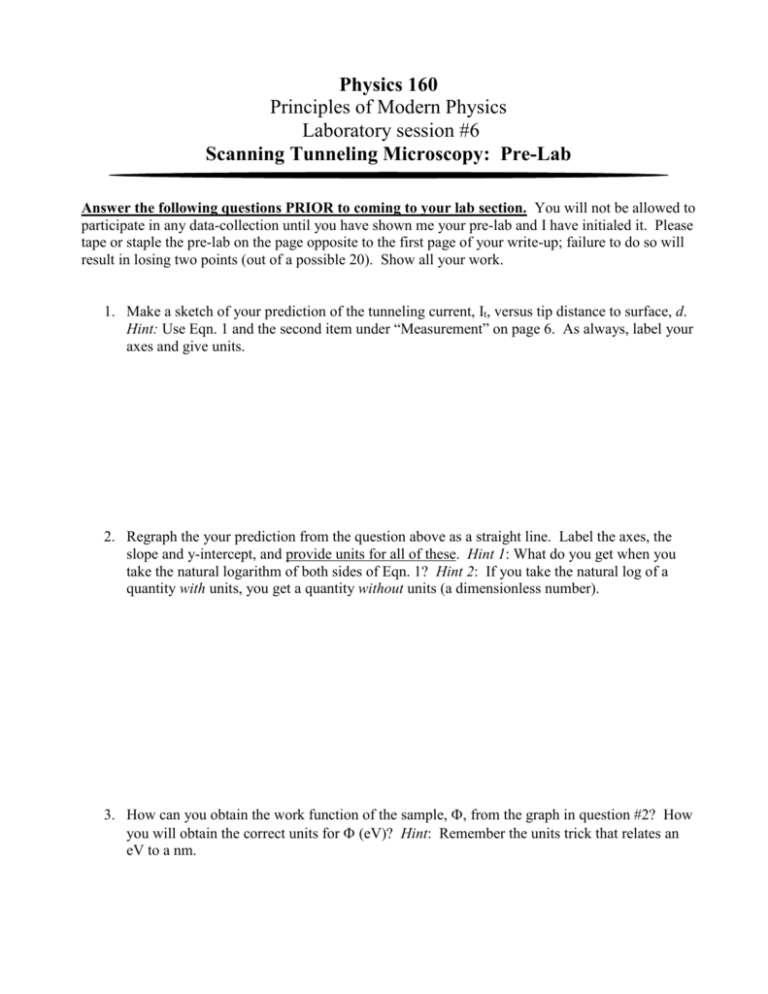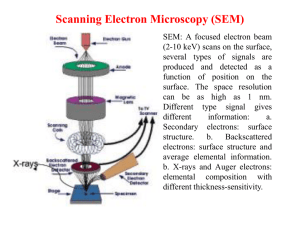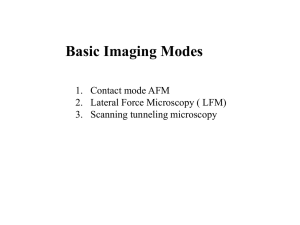Scanning Tunneling Microscopy
advertisement

Physics 160 Principles of Modern Physics Laboratory session #6 Scanning Tunneling Microscopy: Pre-Lab Answer the following questions PRIOR to coming to your lab section. You will not be allowed to participate in any data-collection until you have shown me your pre-lab and I have initialed it. Please tape or staple the pre-lab on the page opposite to the first page of your write-up; failure to do so will result in losing two points (out of a possible 20). Show all your work. 1. Make a sketch of your prediction of the tunneling current, It, versus tip distance to surface, d. Hint: Use Eqn. 1 and the second item under “Measurement” on page 6. As always, label your axes and give units. 2. Regraph the your prediction from the question above as a straight line. Label the axes, the slope and y-intercept, and provide units for all of these. Hint 1: What do you get when you take the natural logarithm of both sides of Eqn. 1? Hint 2: If you take the natural log of a quantity with units, you get a quantity without units (a dimensionless number). 3. How can you obtain the work function of the sample, from the graph in question #2? How you will obtain the correct units for eV)? Hint: Remember the units trick that relates an eV to a nm. Physics 160 Laboratory, Spring 2009 Session 6: Scanning Tunneling Microscopy 2 Physics 160 Principles of Modern Physics Laboratory session #6 Scanning Tunneling Microscopy Objectives: 1) Use a Scanning Tunneling Microscope to produce an image of graphite and interpret your results. 2) Explore the relationship between the quantum tunneling current It and gap distance d. 3) Explore the dependence of tunneling current on the voltage difference between the sample and the tip. Background: The advent of quantum mechanics in the 1920’s contributed immensely to our understanding of atoms, nuclei, molecules, and solids. New ideas in statistical mechanics accelerated the quest for greater understanding of the behavior of liquids and solids (condensed matter). In the last half of the 20th century, the study of condensed matter (semiconductors, superconductors, magnetic systems, superfluids, polymers, and synthetic nanostructures) became the largest single subfield of physics. The study of surfaces plays an important role in condensed matter physics, with particular applications in semiconductor physics and microelectronics. In the early 1980’s Gerd Binnig and Heinrich Rohrer at IBM’s research laboratory in Zurich developed the scanning tunneling microscope (STM) in order to explore the physics of surfaces. In 1986, their accomplishment was recognized with the Nobel Prize in Physics. The device uses the phenomenon of quantum tunneling to make extremely sensitive maps of surfaces that can resolve individual atoms in a surface. In this exercise you will use an STM to create an image of a solid surface with atomic resolution. Introduction: With a scanning tunneling microscope, images of surfaces with atomic resolution can be readily obtained. The images produced by this instrument are not like those from any type of optical microscope since the STM does not use reflected light to create a magnified image. Rather, an STM uses quantum tunneling of electrons to map the density of electrons on the surface of a sample. Since electron density is generally greater near the nucleus of an atom located at the surface of the sample, the STM image can be used to determine the position of those atoms on the surface. Physics 160 Laboratory, Spring 2009 Session 6: Scanning Tunneling Microscopy 3 Fig. 1. Mapping the surface of a sample with an STM. The STM works by bringing a metal wire with a sharp tip very close to a conducting surface. The distance is generally on the order of 1 nm, a distance corresponding to a few atomic diameters. Electrons in the tip and the sample are classically forbidden from traversing the region between the tip and the sample, and no electrical current should flow from the sample to the tip. However, if the gap between the tip and sample is sufficiently small and a small voltage Vt is applied, quantum mechanics allows the electrons to tunnel between the sample and tip and a small tunneling current It flows. In the simplest model of quantum tunneling, this current is exponentially dependent on the distance d between the tip and structures on the surface of the sample. The tip is scanned over the surface of the sample while keeping either the height z or the tunneling current It constant. A computer maps the surface by scanning in parallel lines across the surface and recording either It or d as shown in Fig. 1. By plotting tunneling current or height as a function of position, a three dimensional representation of the surface is obtained. A sample image of a graphite surface in Fig. 4 shows a plot of tip height vs. position along one line of the image together with a plot of a 1.1nm x 1.8nm portion of the surface. Quantum Electron Tunneling In classical mechanics, an electron moving in a potential V(z) with total energy E is described by the equation: pz2 eV (z) E total 2m where pz mvz is the z component of the electron’s momentum, e is the charge of the electron, and m is its mass. The electron has a nonzero momentum and is allowed to move only in regions where ETotal > V(z). Fig. 2 depicts the potential energy eV(z) of an electron as a function of position. The potential energy is low inside the material of either the sample or tip because the electron is attracted to the positively charged nuclei in the solids. The potential energy rises abruptly at the edge of the material. The horizontal line at energy E indicates the total energy of a given electron. Physics 160 Laboratory, Spring 2009 Session 6: Scanning Tunneling Microscopy 4 Fig. 2. Potential energy as a function of position showing the sample, tip, and gap regions. The horizontal line represents the total energy of an electron in this system. Classically, an electron of energy ETotal can be found in the region z < 0 or in the region z > d, but never in the gap region 0 < z < d. In quantum mechanics, the properties of the electron are determined by solving the Schrödinger equation and this strict prohibition is relaxed. The state of the electron is described by an electron wave Ψ(z) that is related to the probability that one will find the electron at some position z. This wave must satisfy the Schrödinger wave equation of quantum mechanics. Fig. 3 shows plots of the wave function Ψ(z) both inside and outside the classically forbidden gap region. Fig. 3. Quantum wave function for an electron of total energy E in the potential energy environment described in Fig. 2. Inside the sample, the electron wave has a large amplitude corresponding to a high probability that the electron will be found inside the sample with the momentum expected classically. In the classically forbidden gap 0 z d , the wave function is approximated by the decaying exponential (z) (0)ez Physics 160 Laboratory, Spring 2009 Session 6: Scanning Tunneling Microscopy in the limit d 1 , where 2m 2 5 V0 ETotal 2m 2 is called the decay constant. The constant is the work function of the electron since it is the energy needed to overcome the attraction of the metal for the electron. This wave depicts the state of decaying probability for finding the electron in the gap between sample and tip. The probability for finding an electron near a point z is proportional 2 2 to (z) (0) e2z , which is nonzero inside the barrier. To the right of the gap (inside the tip) the wave oscillates again but with small amplitude, indicating that there is only a slight probability that the electron passes across the forbidden gap and appears in the tip. The amplitude of this wave is found by matching the boundary conditions imposed by the Schrödinger Equation. Notice that the probability density of an electron tunneling through the gap decays exponentially with respect to the width of the gap d. Tunneling Current: Electrons can tunnel from the sample to the tip or from the tip to the sample. The model wave above represents the case where electrons approach the gap from the left side and no electrons come from the right. If there are initially electrons on both sides of the barrier with the same energy, then the number tunneling from right to left equals the number tunneling from left to right and there is no net current. By applying an external tunneling voltage Vt , we can raise the energy of electrons on one side relative to the other by an energy eV and create the situation depicted in Fig. 3 where there are electrons of energy E on one side and none on the other. We predict a tunneling current It (d) A(E)eVt ed . Io (1) This equation predicts that the tunneling current It decreases exponentially with distance d and increases with voltage potential Vt. Io is a normalizing current that makes the right hand side of the equation dimensionless. The function A(E)eVt represents the number of electrons with energies in the range E eV , E in the sample. If the number of electron states with a given energy is constant independent of energy then we expect the current to increase linearly with voltage. However, if the number of states per unit energy depends on the energy itself the curve will no longer be linear. For example if A( E) A E0 A1 E E0 in the vicinity of energy E0, the average value of E E0 needs to be included. Since E E0 ranges from 0 to eVt, the average value will be 1 eVt . We would 2 then expect tunneling current to look like a quadratic equation. Measurements: 1.) Use the STM to produce an image of the surface of crystalline graphite. Follow the instructions of your lab guide to a. Move the tip close to the surface and establish the tunneling current; b. Adjust the scan so that it is parallel to the crystal surface; c. Gradually look at smaller sections of the surface until atomic features emerge. Notice the honeycomb structure that appears. An actual image of a graphite surface obtained with one of the instruments in the surface physics laboratory is shown in Fig. 4 below. Physics 160 Laboratory, Spring 2009 Session 6: Scanning Tunneling Microscopy 6 2.) Use the spectroscopic mode of the STM at one point to make a plot of tunneling current as a function of distance to the surface. Note that the positive direction points toward the surface rather than away so your plot of It vs d (labeled z on the computer program) will be exponentially increasing rather than decaying. As discussed in the pre-lab, plot your data as a straight line. Use your line to estimate the barrier height. You may need to truncate your data set to look only at the smallest current values. How can you justify not considering the other data in your analysis? The work function for graphite measured using the photoelectric effect is 4.5 eV. How does your result compare? Can you think of a reason for the discrepancy? 3.) Again use the spectroscopic mode to make a plot of current vs gap voltage. Is your result consistent with equation (1) assuming that A(E) is constant? Is the quadratic version better? 4.) All of the equations come from a very simplified model of tunneling that is valid when the tunneling current is small (large gap) and also for one dimensional models. Do you expect that the sharp tip will cause the results to change? Fig. 4. The graph on the left shows the vertical position of the tip relative to the sample as the tip scans across the line in the image corresponding to the arrow in the right panel. The instrument adjusts the height to keep the tunneling current at precisely Io = 1 nanoampere ( 1 10 9 ampere). The right panel shows a representation of the set of lines that cover the full 1.11 by 1.84 nanometer region under examination. Physics 160 Laboratory, Spring 2009 Session 6: Scanning Tunneling Microscopy 7 Setup This part of the procedure will be done before you enter the lab and will only be necessary if you need to replace a tip in the process of your experiment. You should begin at the automatic tip approach step. Installing the sample - Pick up the metal sample disk by grasping it in a tweezers on the circumferential edge (see Fig.5). - Hold the sample holder by the black plastic end and center the sample disk on the magnetic end of the sample holder. Put the sample holder down on the guide bars of the scan head first and then gently release it onto the piezomotor’s support. Make sure to avoid hitting the scanning tip with the sample. - Starting the microscope - Turn on the microscope power supply. The red LED on the control electronics should turn on. - Double-click on the “EasyScan.exe” icon on the computer to start the Easyscan software. When the EasyScan software opens, a dialogue box will appear saying ‘Downloading code to microscope…’. After the download is complete, the LED on the scan head will be orange. Coarse tip approach - Gently push the sample holder by the black plastic end until the sample is within 1mm of the scanning tip. Use the magnifying glass and the reflection of the tip off the sample to guide you. Place the transparent cover over the scan head being careful not to touch the sample holder. Adjust the magnifying glass on the cover so you get a good view of the tip and the sample. Physics 160 Laboratory, Spring 2009 Session 6: Scanning Tunneling Microscopy 8 Fine tip approach - - Choose the menu “Panels” on the “EasyScan” program. Open the “Approach Panel” dialogue box. Click on the down arrow in the “Approach Panel” to move the sample closer to the tip. Watch the tip and its reflection on the sample through the magnifying glass to move the sample within a fraction of a millimeter of the tip. Open the “Feedback Panel” in the menu “Panels”. Set the following parameter values: • Set the “SetPoint” to 1.00nA. • Set the “GapVoltage” to 0.05V. • Set the “P-Gain” to 12. • Set the “I-Gain” to 12. Automatic tip approach - Click on the “Approach” button on the “Approach Panel”. The computer should automatically move the sample to the proper distance from the tip. If the approach was successful, the LED on the scan head should turn green and the “Approach done” dialogue box will appear. - Click “OK”. If the tip “Crashes”, the LED on the scan head will turn red. This means the scanning tip has been damaged and must be changed. Contact your instructor for help in installing a new tip. Starting measurement - Click on the “Full” button in the “Scan Panel” to maximize the scan range. - Start scanning the surface by clicking on the “Start” button in the “Scan Panel”. In the “LineView” panel, you will see an image of the scan measurement. In the “TopView” panel, you will see an image of the measured plane of the surface. The “LineView” image should be a smooth line. If the “LineView” image is very rough or inconsistent then the scanning tip probably needs to be changed. Adjusting sample tilt coordinates Unless the line in the “LineView” panel is parallel to the dashed line, the sample’s surface is tilted with respect to the scanning plane. The slope of the scanning plane must be adjusted so that it is parallel to the sample’s surface. - Set the “Rotation” value on the lower part of the “Scan Panel” to 0° to scan along the xaxis. - Use the arrow buttons to adjust the value of “X-Slope” until the scan line lies parallel to the x-axis. - Set the “Rotation” value to 90° to scan along the y-axis. - Use the arrow buttons to adjust the value of “Y-Slope” until the scan line lies parallel to the y-axis. - Reset the “Rotation” to 0°. The tilt of the sample relative to the scanning plane has now been corrected. Physics 160 Laboratory, Spring 2009 Session 6: Scanning Tunneling Microscopy 9 Imaging of atomic structure of graphite Use the STM to get an image of the atomic structure of graphite. - Open the “Scan Panel” in the Easyscan software. - Click on the “Start” button to start scanning the surface of the sample. - Reduce the value of “Z-Range” in “Scan Panel” to 50nm. - Click on the “Zoom” icon on the top of the “Scan Panel”. The mouse becomes a cross and the “Tool Info Panel” opens. - Look for a fairly flat region in the “Top View” panel and make a box with the mouse. The “Tool Info Panel” displays the size and location of the box. - Release the mouse button when the size is about 30-50nm. - Double-click the left mouse button to zoom in on the selected box. - Set the value of “ScanRange” to about 2nm. - Set the value of “Z-Range” to about .75nm. - Set the value of “Time/Line” to 0.06s. You may need to slightly adjust these parameters to get a good image. It may take a few minutes for the image to stabilize due to thermal drift and stabilization of the tip and sample. Try to avoid heavy footsteps or bumping the lab bench, as the STM is very vibration sensitive. - Optimize the color range in the “TopView” panel by clicking on the “Optimize” icon in the “View Panel”. Once you are satisfied with the image you get, you can save it and print it out. - Click on the “Photo” icon in the “Scan Panel”. After the current scan frame has completed, a copy of the image will appear behind the “Scan Panel”. - Click on the photo image to select it. - Under “File” select “Export” and select “View as…”. - Save the file as a Bitmap, .bmp, file. You can view or print the image from Easyscan or by opening it in Paint Shop Pro. To help under stand the image, you may wish to read “Note about the graphite surface” on p.33 of the EasyScan introduction manual. Remember that the STM does not image atoms themselves. It actually measures the density of electrons on a surface. Though electron density is generally highest near an atom, chemical bonding and other phenomena can affect the STM image so that it doesn’t actually represent the atomic structure of the surface. If you have time use the measuring tools to put some dimensions on your map of the graphite surface. Measuring It versus d - Open the spectroscopy panel by clicking on the “Spec” button on the top of the “Scan Panel”. Set the parameter in the “Output” box to Z-axis. Set the value in the “From” box to 0.000nm. Set the value in the “To” box to 4.000nm. Set “Averages” to 64. Set “Time/Mod” to 0.069s. Set “Samples” to 256. “X” the box next to “Rel”. Under the “Input level” select “Mod”. Click on the “Start” icon to run a measurement. Physics 160 Laboratory, Spring 2009 Session 6: Scanning Tunneling Microscopy 10 If the It vs. d graph in the “Line View” screen doesn’t look like a smooth curve, you may need to run another measurement by clicking the “Start” icon. When you are satisfied with the curve you get, you can move on to saving it. - Click on the “Photo” icon to take a picture of the spectroscopy panel. - Click on the “Line View” in the photo panel to select it. - Under “File” select “Export” and select “View as…”. - Save the file as a Comma Separated Value, .csv, in your network space for future reference. Measuring It versus Vt Open the spectroscopy panel by clicking on the “Spec” button on the top of the “Scan Panel”. - Set the parameter in the “Output” box to GapVoltage. - Set the value in the “From” box to 0.000V. - Set the value in the “To” box to 1.400V. - Set “Averages” to 64. - Set “Time/Mod” to 0.069s. - Set “Samples” to 256. - Un “X” the box next to “Rel”. - Under the “Input level” select “Mod”. - Click on the “Start” icon to run a measurement. If the It vs. Ut graph in the “Line View” screen doesn’t look like a smooth curve, you may need to run another measurement by clicking the “Start” icon. When you are satisfied with the curve you get, you can move on to saving it. - Click on the “Photo” icon to take a picture of the spectroscopy panel. - Click on the “Line View” in the photo panel to select it. - Under “File” select “Export” and select “View as…”. - Save the file as a Comma Separated Value, .csv, in your network folder. - Analyzing data The .csv file format that you saved your measurement as can be opened using Microsoft Excel. The data will be divided into two rows representing all the data points collected in the measurement. The top row should be the x-axis data from the graph on the “Line View” panel and the second row should be the corresponding y-axis data. This can be changed to twocolumn format by copying and pasting with the “Paste Special” option in Excel by checking the “Transpose” box. You can copy and paste the data directly into a data table for a Kaleidagraph plot. Try plotting the data directly and performing an exponential curve fit or plotting the data logarithmically and perform a linear fit.







